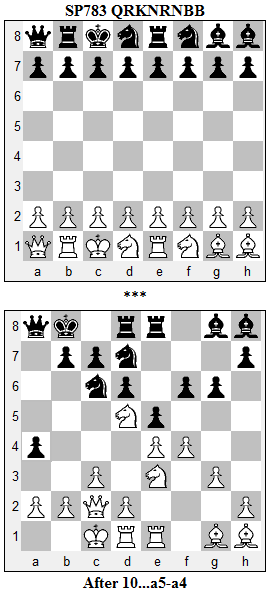SP783 presents a couple of awkward challenges. First, the Queens are in a corner facing a Bishop at the other end of the long diagonal. On top of that, castling O-O-O looks to be more likely than O-O, but the King on the a-side will be under pressure from the enemy Bishops sitting on adjacent diagonals. How did the game proceed?

The second diagram shows the position after ten moves have been played by each side. Using the techniques that I introduced in Count the Developing Moves and Move Order in the Opening, let's summarize the development thus far.
White has made four Pawn moves, Black six (the a-Pawn has moved twice). Both players have castled O-O-O as expected. Of his remaining five moves, White has made three with the Knights to take control of d5, and two with the Queen to transfer it to c2. Of his remaining three moves, Black has taken two to get the Knights off the back rank and one to move the King to b8.Neither player has moved a Bishop, but all four are already playing an active role in the game; moving the f- and g-Pawns was sufficient to activate them. Except for castling, neither player has moved a Rook, but all four are developed on central files, waiting for lines to open.
All things considered, White's position makes a better impression. The Queen and Knights are more active, while the d2-d4 break is a bigger threat than Black's pushing the a-Pawn. Although White went on to win, it would take a more profound analysis to determine if the seeds of victory were already present in the diagrammed position. Here is the complete game score, courtesy of SchemingMind.
[Event "2009 Chess960 Dropout Tournament"]
[Site "SchemingMind.com"]
[Date "2009.07.02"]
[Round "3"]
[White "Tyler"]
[Black "wilfried"]
[Result "1-0"]
[Variant "fischerandom"]
[SetUp "1"]
[FEN "qrknrnbb/pppppppp/8/8/8/8/PPPPPPPP/QRKNRNBB w KQkq - 0 1"]
1.f4 g6 2.e4 Nc6 3.Nde3 O-O-O 4.O-O-O d6 5.g3 Kb8 6.c3 e5 7.Nd5 f6 8.Nfe3 Nd7 9.Qb1 a5 10.Qc2 a4 11. Kb1 Ne7 12.Nxe7 Rxe7 13.d4 Qa5 14.fxe5 fxe5 15.d5 Nb6 16.b4 axb3 17.axb3 c6 18.c4 Bg7 19.Re2 Kc7 20.Qa2 Qxa2+ 21.Rxa2 Nc8 22.Kc2 h5 23.b4 Red7 24. Bg2 Bh6 25.Bh3 Rh7 26.Ra8 h4 27.Bg4 hxg3 28.hxg3 Nb6 29.Rxd8 Kxd8 30.c5 1-0
I'm not sure why Black resigned, but he must have been looking at material loss and had too much respect for his opponent's endgame skill to continue.

1 comment:
Hi there
Thanks for that beautiful example and discussion about opening principals. I've found myself temporarily throwing out all that I know about SP518 opening tempo theory because of Chess960. At times it has felt like being in a washing machine.
Thanks to your posts here, the reality check of what is possible in the opening tempo phase of Chess960 is restoring some balance to my thinking during the opening phase again. I think in Chess960 we the players need to help each other stay grounded in the absence of any readily available literature on Chess960 down at the local book shop.
When I started out playing Chess, I used to read books on opening theory like candy in a candy store. Never for the specifics just the principals and watching when they get broken for good reason. With Chess960, you start thinking all over again.
On that beautiful game you gave an example of. Black resigned for very good reasons that I can work out with computer assistance. It's a pity that they did not play through the main line. That pawn alignment at the finish is really pretty but deadly for black.
The main issue that I can work out are the key threats white has:
1) The d-file will open
2) White will control the d6 square which exposes black's weak 3rd rank.
3) White can use a check on the d-file to play dxc6 which then hands white control of the d7 square as well!
4) Black's knight plays into the hands of threats 1-3 unless black plays it to Nc4 which is useless and hands white the next strong initiative.
5) White get's control through tempo of either the d-file or f-file as he chooses.
6) White's bishops go into forward positions particular Be6. If white chooses to open the d-file, white's dark bishop sits on the f-file at f6.
7) If white wants to control the f-file with his rook, white's dark bishop sits on g5 controlling e7.
8) Black's 3rd rank (6th rank) is hideously weak and because white indirectly controls key squares on the 7th rank including access to f7, white can even get the rook active on that 7th rank.
9) Essentially all black's pieces are passive, and white has the initiative to begin unraveling it all.
10) Love white's little pawn construct b4-c5-d5-e4. That engineered pawn arch is as strong as any bridge!
Cheers!
Harry
Post a Comment